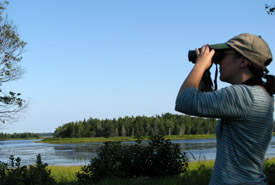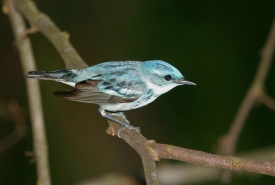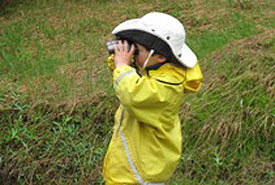Sky-high conservation: Why monitoring birds is important

An osprey soars around its nest (Photo by Lorne)
You may have heard about the dramatic population declines that certain groups of birds — such as grassland songbirds and aerial insectivores —are experiencing. While much attention gets paid to the factors causing these declines and what can be done to halt or reduce them, have you ever wondered how scientists know that these species are declining?
It’s more than simply noticing that a certain species is not as common in a particular area as it used to be. This anecdotal observation, although not overly robust, may be the canary in the coal mine that prompts scientists to dig deeper.

Birding at the Tabusintac Estuary, NB (Photo by NCC)
However, the primary way scientists determine that a species’ population is declining is through monitoring the abundance and distribution of that species over a long period of time. Abundance is determined by counting individuals, while distribution is determined by documenting where the species occurs. Typically, when scientists measure abundance, they are, by default, documenting occurrence as well. Bird abundance is mainly measured by point counts: standing in a location for a specified period of time and documenting all the birds seen or heard during that time and within a predetermined distance.
Many long-term bird monitoring programs rely heavily on volunteers, such as the North American Breeding Bird Survey (BBS). While the program is administered by federal government agencies, the actual surveys are conducted by volunteers. Volunteers sign up for a designated route of predetermined point counts and do that same route every year. Data are submitted at the end of each survey season and added to a continent-wide database. Scientists are then able to use this information to determine trends in breeding bird populations over whole ranges of species and multiple decades.

Cerulean warbler (Photo by Bill Hubick)
The BBS has existed for more than 50 years and is run in the U.S., Canada and Mexico, making it a crucial source for long-term bird count data on a broad scale. The BBS is also a prime example of the value of volunteers and how individuals can contribute directly to science and conservation.
What if you don’t know how to do point counts? Don’t worry. There are many other volunteer-based (often termed "citizen science") projects that monitor birds and don’t require technical survey skills, but still have standardized protocols to ensure consistent and reliable data. Some examples are:
- Project Feederwatch
- Project Nestwatch
- And regional atlas projects such as the Saskatchewan Breeding Bird Atlas
Scientists then use the data collected to answer questions related to various aspects of bird life history and/or population trends.
Next time you're out birding, you can make your data more useful by noting a few additional facts, such as:
- date
- time
- location
- length of trip
- travel distance
Ebird is a popular website where you can enter your observations. Your data then gets combined with other birders' data and is used by scientists to inform migration arrival/departure dates and species distributions.

Codroy Valley birding Conservation Volunteers event, Newfoundland and Labrador (Photo by NCC)
Without monitoring, we wouldn't necessarily know when a particular species is declining or whether any observed declines are local or wide range. As species populations naturally fluctuate in the short term (yearly or every two years), multiple years of data provide a broader picture and allow trends to be gleaned from among the small-scale peaks and valleys. Long-term monitoring also makes it possible to determine how bird populations respond to environmental changes, disease outbreaks or human development.
Annual monitoring by dedicated volunteers is what makes all of this possible.


